#it's model is reused for a group of enemies in the full game and the specific texture is reused for 'woody' but
Text

woag. golems
#sprites#modding#ironically. the base golem is my least favorite#the inferno golem i like the magma i did on it#but the ice and wood golems im very happy with#i didn't even know wood golems were a thing in BD and that's bc 'wood golem' is only an enemy in the BD2 demo#it's model is reused for a group of enemies in the full game and the specific texture is reused for 'woody' but#i saw there was a wood golem of any variety and was like 'oh that's sick what if i give each of the vanilla races their own type'#with wood for elves obviously. rock for humans. inferno for goblins. and ice for dwarves#at least ideally. for some reason animal entity tokens wont actually give dwarves the ice golem#every other race's animal token works great. just not dwarves#so ice golems are just a common domestic instead#close enough#the wood golems im trying to make an actually tough plant type enemy so elves have a lot of fire power in sieges#so far they're pretty tough! turns out making them made of A Lot of tissue layers makes them a lot more durable
11 notes
·
View notes
Note
On the topic of level design, are you given a preset selection of enemies to put around the environment or are enemies made specifically for your needs to match your level design? Does it depend on the game?

The full process of character/NPC creation takes a long time. From the art side, we need to model, texture, animate each NPC. Design-side, we also need to assign them abilities, behaviors, stats, and so on. This all requires a foundation of software engineering that they can actually render and animate like the artists want and behave how the designers want. The long lead time it takes to finish an NPC means the creation process must occur in parallel with level and environment creation in order to hit reasonable deadlines.

If the goal is a completely new level and set of enemies, what we do is start with the high level big idea (e.g. this part of the game will be in an ice dungeon with a frost dragon boss at the end) and then have the individual teams do their work toward that goal. The level designers start blocking out an environment that feels like an ice dungeon, the environment artists start creating assets that look like they belong in an ice dungeon, the character art team starts modeling the monsters that belong in an ice dungeon, and the gameplay programmers start working on features that are needed to make an environment feel like an ice dungeon (e.g. contextual ground textures that make NPCs slip and slide while walking on them).

The ice dungeon level then begins as placeholder assets and rough prototype geometry just to get something working. Then, as each individual part makes progress, we integrate them into the whole. This section of greybox assets gets replaced by ice boulders from the environment team, that group of default bad guys is replaced by ice goblins, this section of ice bridge gets the slippery ice gameplay applied to it, and so on and so forth. We gradually replace the various placeholder assets as the level that started as 100% placeholder assets slowly approaches a finished quality over the course of production.

It's important to note that this extended process only applies to the new assets and features we need to create. After we create our first ice dungeon, we can use most of the same assets to create a second ice dungeon much more easily. It is also much easier to take an existing asset like an ice goblin and modify it a bit (e.g. give it an axe instead of a sword, make it bigger or smaller, change its texturing, give its attacks different effects, etc.) to differentiate it from the previous ice goblins. This is generally why creating DLC content is cheaper than creating content for the base game - we've already built a lot of assets, so we can more easily reuse what we have with some modifications to make "new" things without having to make completely new things.
[Join us on Discord] and/or [Support us on Patreon]
The FANTa Project is being rebooted. [What is the FANTa project?]
Got a burning question you want answered?
Short questions: Ask a Game Dev on Twitter
Long questions: Ask a Game Dev on Tumblr
Frequent Questions: The FAQ
37 notes
·
View notes
Text
I didn’t post about everything I played this year, so here’s my opinions on the stuff I played that I didn’t make a rec post for:
Raging Loop

Raging Loop is one of them twisty meta Zero Escape-y branching-path visual novels where an ensemble cast is trapped in a mysterious circumstance where people are dying gruesomely, and you have to find out what’s happening and stop it by looping a bunch.
I can’t wholeheartedly recommend it, because... it tries to have its cake and eat it too with the supernatural elements. Clearly magic is real and has important impacts on the scenario, but then other parts are trickery you’re supposed to see through, and it’s entirely uninterested in cluing you in to how that trickery was accomplished. Not exactly a fair play mystery, in that regard- you have to kind of just be along for the ride, rather than try to figure it out.
That said, it’s a good ride- pretty strong character writing, and the central conceit of the Werewolf/Mafia-style murder scenario creates really interesting drama. It’s more concerned with making itself feel clever than letting the player feel clever, but it’s still well-paced and gripping and has a pretty decent resolution.
Detective Grimoire
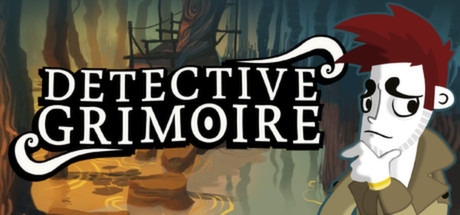
I recommended Tangle Tower, the sequel, pretty strongly- and this one, while obviously a little rougher around the edges with the art and mechanics (the suspicion tracker system is a total dud; I didn’t even realize it existed until I realized I was missing an achievement for using it), it’s still pretty darn good. Really fun character designs and animations, fully-voiced, and a solid whodunit backing it all. Plus- while the two are more or less self-contained, the continuity threads with Tangle Tower raised some really interesting questions.
Contradiction - the all-video murder mystery
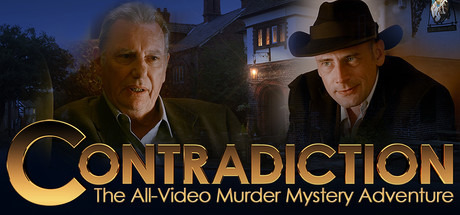
This one was pretty fun, largely on the strength of the actors. The main mechanic of interrogating people on evidence and using their own statements against each other was some good stuff, too. Definitely had that Phoenix Wright quality to the deductions, and Jenks is a really fun character. (Had a few points where progression was just linked to standing in a certain previously-abandoned area of the map where a clue was suddenly there for no reason, there- good thing it had a hint system.)
As a mystery, it could use a little work- most of what you end up finding out is sequel bait (for a sequel that never actually came together, unfortunately), and the actual whodunit is just sort of hiding in the cracks of all that. And... cornering the culprit just sort of happens out of nowhere once you’ve got your hands on the right piece of evidence, without much fanfare. You’re following up on leads like usual, you find a little lie in someone’s testimony, and then- oh, shit, they’re just confessing everything! Unlike all the previous times you questioned them and they were super evasive like everyone else! And then the game is over.
All in all, it’s pretty meaty and entertaining and I’d recommend it, but unfortunately the creators have moved on to other things, so there’s not going to be any follow-up on the stuff it left unresolved.
Ikenfell
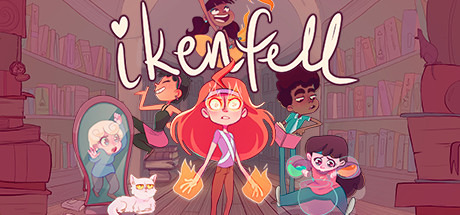
Ikenfell is a tightly-designed RPG about kids at a magic school, with Paper Mario-style action command mechanics and a battle system that makes a big deal out of careful positioning and movement, which was really enjoyable. The difficulty’s a little high (I recommend always always always speccing into max damage because killing things before they kill you is worth more than any amount of defense, speed doesn’t work, and healing is cheap), but I found it really satisfying.
There’s... something... off? About... I don’t know how to put it, it’s... doing that “yes, everyone is queer and mentally ill, deal with it” thing, which, sure, okay. But for a lot of them it’s such a background thing, like... half the playable cast is unambiguously nonbinary, but like... I don’t know if it’s trying to make some statement on how there are no rules to being NB and you can 100% perform a particular binary gender presentation but still count, or if they wrote the whole story and then changed the pronouns of some of the characters for Representation Points, or what. Probably the former? I dunno, it just feels weird. Maybe I’m just not woke enough to Get It.
(unrelatedly: why the heck is the official art they use everywhere so... off-model? none of them look like they do in-game- they look like the creator commissioned someone to draw a group shot with one reference image each and didn’t tell them anything about the characters. how much you wanna bet they commissioned a friend and it came out wrong but they were too polite to say “sorry, no, this is wrong, can you do it over?”)
Trails of Cold Steel IV

Hoo boy. It’s... not great, and it’s not great in a pretty predictable way for an even-numbered entry in the Trails series. It happens every time- first there’s a game in a new engine with new characters and a new world to explore, and it’s really nice and does interesting things... and then it ends on a cliffhanger, and then there’s a sequel game in the same engine with the same characters and the same world, reusing as many assets as possible. Also the League Of Generically Evil Anime Supervillains is there causing trouble for reasons they refuse to explain, and the plot is a storm of magicbabble and macguffin-chasing that makes little to no sense.
Cold Steel IV is that for Cold Steel III, full stop. Welcome back to all the same places you visited last game, except this time there’s some stupid magic apocalypse happening (not that it stops you from taking the time to do random sidequests constantly, of course). The whole “oh, the evil curse mind controls people and that’s why they do stupid bullshit that’s in no one’s interest” plot point is leaned on super hard, and it’s just a big yawn the whole way through.
It’s still really fun, though, because the battle system remains really well-designed. (The same battle system that was just as fun in Cold Steel III, mind you, but it hasn’t gotten old.) And- though they’re struggling to square it with the dumb mind control apocalypse plot, the NPC dialogue continues to make the world feel believable and lived-in. They don’t slack on the parts that make Trails good- it’s just the parts that make Trails bad are making themselves more evident than ever.
did finally get to date Towa though so that’s a win
One Step From Eden

OSFE is... uh. It’s fucking hard is what it is. It’s sort of a deckbuilding roguelike, and there’s this combat that takes place on a grid, and- wait, it’s like Mega Man Battle Network, it’s exactly like Mega Man Battle Network. Man, I forgot about that, but the mechanical influence is extremely obvious. It’s MMBN meets Slay the Spire.
Except it’s super duper hard as hell, because unlike MMBN you can’t pause and swap out chips or anything- everything is just always happening so much, all at once, everywhere, and you have no recourse but to git gud and learn all the enemy patterns and the behavior of your own spells and develop the twitch reflexes necessary to not fucking die from all the shit that’s on the screen always.
(What’s the story? Uhhhh, there was some kind of magic apocalypse, and some anime girls are trying to reach a city for some reason that doesn’t really get explained ever. The game doesn’t really care to build its world at all- it’s all mechanics plus a little token character dialogue that doesn’t say much.)
The point is it’s really frickin’ hard but I am an epic pro gamer and I got ALL THE ACHIEVEMENTS, MOTHERFUCKER. If you’ve played it, I expect you to be really god damn impressed with me, okay???
A Short Hike

This one was really relaxing! It’s a platformer where you explore an Animal Crossing-y island of cartoon animal people, collecting mobility upgrades- but like, mainly it’s about straight chillin’. The flight controls are fun and there’s lots of little secrets to find and it’s just a nice time that doesn’t drag on too long. Not too much to say about this one.
Pokémon Sword

Ehhhhh.
I’m not here for the hot takes about how Dexit is good actually. Development hell happened, they had to make cuts for time, I get it. It’s disappointing and makes the game a little bit worse, but it’s not the end of the world.
Apart from that... perfectly serviceable? The Wild Area could’ve used a little more technical polish (as could most things in the game, really) but was a step in the right direction, giving the player a wider array of early-game team-building options than ever before. No HMs is good. Story and characters were kind of nothing, but that’s par for the course. “At least this time they’re not shoehorning in some kind of stupid evil-team-wants-legendary-pokemon-to-destroy-the-world apocalypse plot”, I thought to myself before they managed to shoehorn one in at the last minute with zero buildup- but, hey, beats wasting half the game on it.
It’s nothing special and it’s missing a lot of polish, but its problems are mainly due to being rushed, and presumably next gen they’ll be able to reuse a lot of the models and animations (maybe even improve the animations so they’re not so boring??? a man can dream) and make something interesting. SwSh seem like they were testing the waters for something else, and not taking too many chances in the meantime.
(yo why would you sell all these cosmetic items and then turn them all off during gym battles, though)
Hades

Hades is- oh, who am I kidding? Everyone knows Hades, it’s the game of the year, greatest thing since sliced bread, Supergiant are heroes, yada yada yada. I’ve played almost 300 hours of it and I’ve completed everything except all the Resources Director levels (currently a Sigma Wraith), it’s extremely fun and you don’t need me to tell you that.
Petal Crash
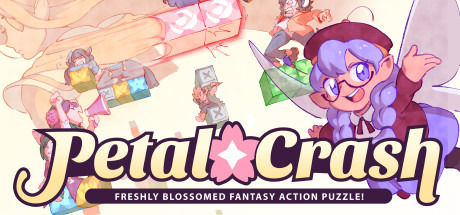
It was that thing the Paranatural creator helped on? It’s, uh. It’s a block-sliding puzzle game thing, sort of in a Puyo Puyo vein. It has fun character designs and some good dialogue, like you’d expect from Zack’s involvement, but it didn’t really leave an impression otherwise (besides how got dang infuriating some of its Turn Trial puzzles can be.) The story is... kinda heartwarming, kinda didactic, kinda childish, not especially deep or interesting. Hard for it to be, when it’s told through little bits of fluffy character dialogue that exist to set up a puzzle battle as quickly as possible. Not super recommended unless you really really like block-sliding puzzles.
Hollow Knight
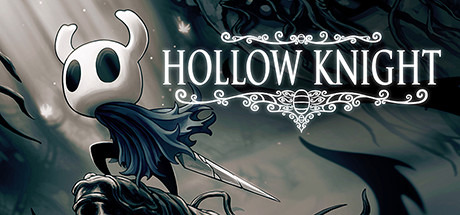
Man, why’d I sleep on this for so long? It’s a metroidvania platformer with heavy Dark Souls inspiration, in terms of tone and difficulty and death mechanics and environmental storytelling. And it’s... apart from all that, just really good as a game, with tight controls and juicy movement and great animation. Progression is linked as much to mastery as it is to upgrades collected- I found myself in lategame areas facing down things that would’ve killed me ten times over at the start- not because I had the best gear, but because I’d learned the game’s language and understood how to move in ways that wouldn’t get me killed.
(Usually. Sometimes I’d walk into a room and sit on a bench and suddenly there’d be a boss fight and I’d get slaughtered. Ain’t that just the way it goes?)
Anyway, on top of all that it’s just charming as hell, with a really unique and well-realized world full of little bug people. I love how, like, your character is clearly some kind of eldritch abomination, but it’s small and cute and so everyone (besides enemies that attack you on sight because they’re possessed by some kinda evil mold) is like “awww, who’s this little guy? want some help, little guy?”
(except Zote, who is just an ass hole. i love him.)
39 notes
·
View notes
Text
Fallout 4: Nuka-World DLC
youtube
Nuka-World trailer featuring DLC cover art by John Gravato.
It has been a while since I have had the time to post and I wanted to get something up about Nuka-World. Rather than hit all of the details in a bunch of smaller Nuka-World posts I decided I would cover as much as I could in one overview post. While re-watching the trailer recently, I was reminded of just how many different aspects of that DLC I got to work on as the art lead. Highlighting my work from the trailer felt like a good way to run through my efforts, so take a look at the trailer linked above and then read on below.

Nuka-World screenshot I created for marketing.
My general responsibilities began with creating the pitch for the DLC. The two design leads, Justin Schram and Alan Nanes, and I started developing a series of ideas for the DLC. After one false start, we came in with a stack of new ideas as one-sheets and started the pitch meeting with what was then called “Raiders and Rides” as a working title. Todd accepted it before even hearing the other ones. I was very happy about this as it was my favorite pitch of the group.
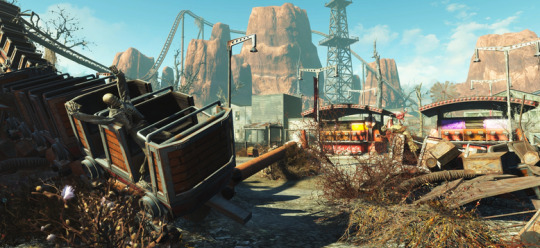
Nuka-World screenshot I created for marketing.
As the art lead for the project I was responsible for overseeing all things art-related; art direction, pipeline, etc. Since this was a DLC for Fallout 4, much of the core art direction was established by Istvan Pele, the art director on the base game. My job for the DLC was to create a reason for players to want to come back to the game for more. I also wanted to test some of my ideas for improvements to the pipelines and the smaller scale of a DLC was a great place for that. More than anything I wanted to use my additional influence on the DLC to give the players loads of memorable fun and value for their money.
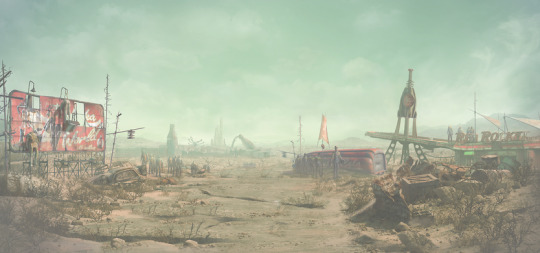
My Nuka-World key art based on the original Fallout 4 key art.
One of the first things I did once the plan was greenlit was to create the key art. I used it in all of my slides for internal and external presentations and to set the initial tone and pillars of the DLC for the team. More detailed post on the key art here.

My original Bottle & Cappy slide art turned into Nuka-World coffee mug art.
A key contrast built into the DLC from the start was the mix of horrible, violent, raider gangs with the fun, lighthearted, theme park. To add that contrast into my slides I created a closing slide featuring who I imagined the park mascots to be. Bottle & Cappy were born as a way to incorporate a fun note as my closing slide. As the DLC progressed it became clear we needed to use them in the park and then in the marketing. Post DLC they have joined the permanent Fallout lore in other titles and in merchandising.

Nuka-World screenshot I created for marketing.
As the first artist on the project, I started by sketching key broad strokes of the DLC into the engine to guide the art team toward my vision. I added in the first-pass landscape and weather to get the environment feeling like I wanted. Then I started blocking in key landmarks of the park in grey boxed art to get the layout started. I added sub leads for the park environment art (Jason Muck) and the landscape (Andrew Barron). To help build enough new geometry to fill the park, I prototyped some park assets using the color remapping I developed for the base game. This workflow would allow faster park asset creation allowing us to build a larger environment with a smaller team.

Nuka-World screenshot I created for marketing.
Once the environment team was going I shifted focus to characters, creatures, and weapons. I knew they going to take much more hands-on work from me duse to the small team size. We had one character artist (Charles Kim) and one weapon artist (Dane Olds) in house. Concept art and the bulk of the non-environment art was planned to be outsourced. Raiders were the main focus for the DLC and I knew they would take up the majority of the resources. Inspite of that limitation I also wanted to get the players as many new creatures as I could. I came up with a list of easy but dramatic creature ideas to test to maximize reuse but feel new to the player. I did fast "proof of concept" tests for each idea to determine which ideas would work in-game. I repeated this same pattern to fill out the weapon list with cheap and fun additions at a minimal cost.

Nuka-World screenshot I created for marketing.
The raider gangs were the main feature of the DLC but due to the volume of work they required, and our lack of staff in those departments, the decision was made to outsource all of the raider concepts and the models. I knew outsourcing the concepts was going to be tricky since the outsourcing group was in China but I had no other option. I supplied lots of ref and photo bashed some quick collages to get something for them to start with besides a written description. This method yielded a few good designs but nothing good enough to move forward with alone. Luckily for me, John Gravato (concept artist) stepped up and took on wrangling some of the design revisions and additions in his spare time. Ray Leder (concept artist) also knocked out a few additional helmet designs. Leveraging their stellar support and iterating with the team in China I was able to arrive at the armor sets that defined the three raider gangs and could combine for massive variety for the player.
youtube
My trailer directorial debut: the Nuka-World E3 teaser.
For this DLC, in particular, Todd's plan for us was to market it like a full game. This meant we would work with marketing on screens, a teaser, a trailer, a theme song, a Bottle & Cappy trailer (similar to the SPECIAL videos for the base game), and a physical park map. The Bottle & Cappy trailer was handled by an outside vendor which took most of the load off of us except for lite direction and feedback. The rest was up to myself and a handful of people on the team. Animator Neal Thibodeaux did a lot of the heavy lifting on both the teaser and the trailer which were both made in the engine. Artist Natalia Smirnova created the logos and artwork for the map and we worked very hard to make it accurate to the park and have that authentic theme park map feel. Not only were we going to use it to guide people around the park in-game, we were also putting a physical version in Game Stop as a preorder bonus.
youtube
Bottle & Cappy trailer.

Nuka-World park map pre-order bonus.
One of the things that got me the leadership role on the DLC was my history of adding all kinds of content to the game in addition to my role as a VFX artist. I don't like it when a good idea dies from a lack of resource time. Over the years I have learned all of the workflows in our engine to find clever ways to make my ideas come to life without additional help. This often includes sourcing existing art for kitbashing new work from in order to save time. Unfortunately, this is the kind of work that has often proven hard to teach and or delegate. Having the lead role allowed me to incorporate it more than ever before into our pipelines, but throughout the DLC I still had to do a lot of the work myself.
Below is a breakdown of all of my work in the trailer which turns out to be a good cross-section of all of the additional things I did on the DLC.

00:02 Direction and feedback for outsourced Bottle & Cappy video.

00:15 Unique models and editor setup for Nukatron.
Flipbook port of B&C video for in-game Nukatron and Nuka-Cola machines.

00:20 Water VFX for the landscape.
Art direction for the five themed areas of the park.

00:23 Ported mannequin models to animatronics and animated them. Created all Nuka-World mannequin outfits as texture swaps or new meshes.

00:24 Set dressed and captured trailer footage in-game.
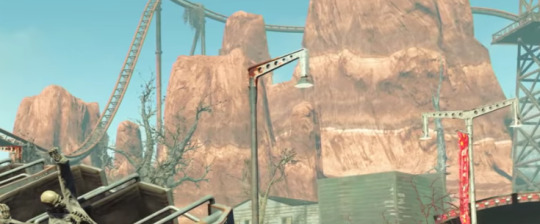
00:26 Developed efficient color remapping pipeline (CRP) for the fast creation of park assets.
I built fake western mountain rocks for themed park area.
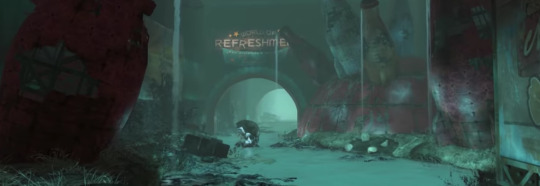
00:28 Created a quantum variant for all 6 Mirelurk creature types.
Created the water and VFX for the Quantum river.

00:30 Concepted and built the armor for Porter Gage the main companion for the DLC.
Modeled and posed Bottle& Cappy park sculptures (using CRP).
Built the Fizztop Mountain asset for the main landmark for the park (using CRP).
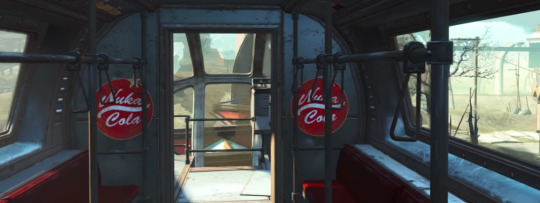
00:40 Technical assistance on execution of the intro train ride.

00:42 Created park color guide and prototype weathers for DLC color direction.

00:43 Concepted and built Nuka bottle Protectron (using CRP).

00:45 Art direction for park map and then execution of in-game navigation via map kiosks.
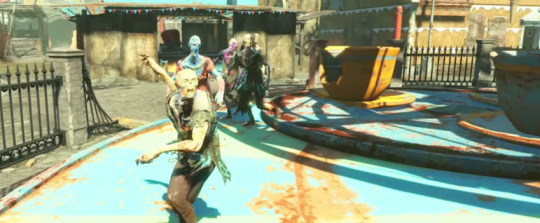
00:48 Created all of the painted feral ghoul DLC variants.

00:51 Created the Gatorclaw death claw variant model.
Created a Nuka-World specific lunch box player prize system from my lunch box system in the base game.

00:52 Created the Brhamaliff models.
Planned a high-level melee tree with art assets to supplement a limitation of the base game.

00:56 Created the unique robot meshes for Nuka Spray Mr. Handy
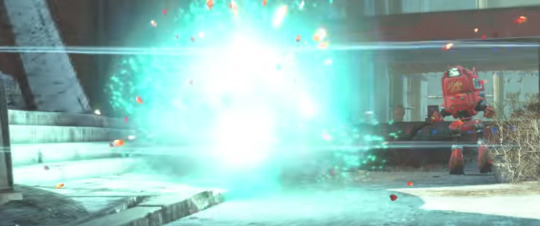
00:57 Designed the damage structure for weaponized Nuka-Cola flavors.
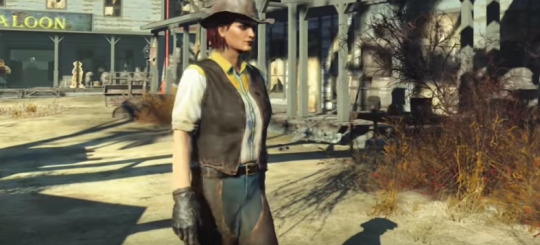
00:58 Created all of the western clothing meshes.

01:00 Prototyped the original sandworm concept in-game to test viability.
Created the Sandworm VFX.
Trained the character artist in kitbash modeling to add Acid Soaker.
Created all of the VFX for the acid soaker.

01:03 Art directed the raider factions.
Designed all clothing as armor/under armor for maximum mix and match.
Cleaned up all outsourced outfit meshes for maximum compatibility within the armor system.

01:04 Created all texture variants for raider underclothes.
Brought the slave collar from Fallout 3 and rebuilt for Nuka-World with power on/off functionality.

01:07 Added motion to some Bottle & Cappy statues.

01:09 Designed trash pile loot system to add the feel of overflowing trash at a theme park and add a new loot system to the park.
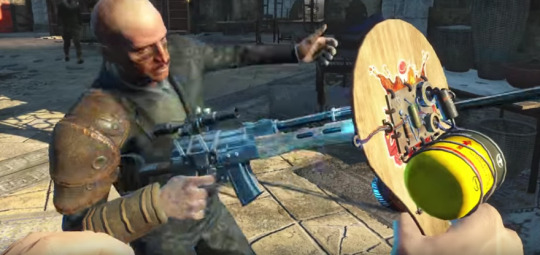
01:13 Concept and design for paddleball weapons and mods. (see other post)
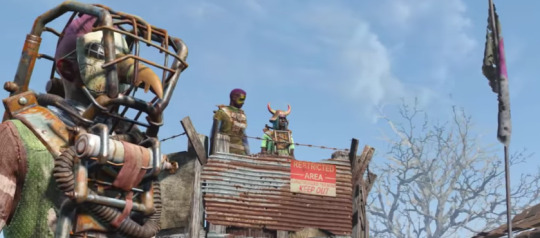
01:18 Art direction for raider gangs.

01:19 Ported alien mesh to animatronic enemy for the park.
Revised the Fallout 3 alien blaster as playable weapon (not shipped).
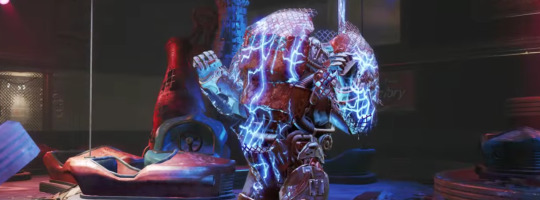
01:20 Built the Overboss bumper car power armor.
Worked with design to create the plan for the opening boss fight with squirt gun mechanic (see other post).
Built all of the electric VFX for the boss fight.
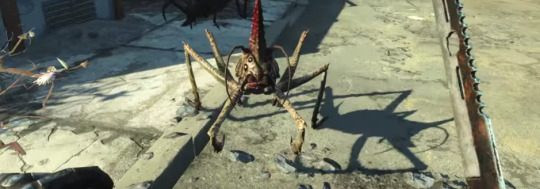
01:21 Original concept for spider cricket hopper enemy.
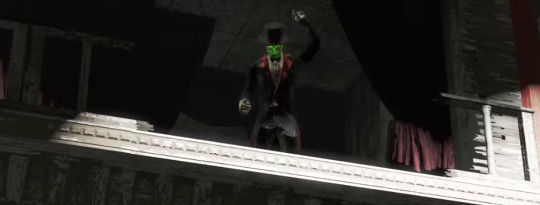
01:17 Tuxedo mesh for Kiddie Kingdom boss ghoul.
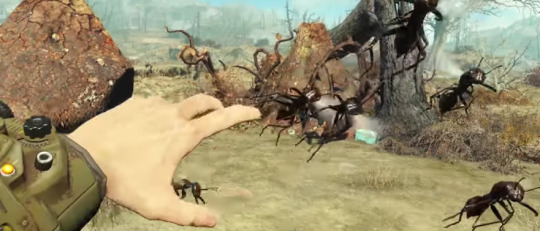
01:23 Flying swarm as a single enemy proof of concept.
All ant variant meshes.

01:28 Shot this shot setup and set dressing for the teaser.

01:33 Original Bottle & Cappy idea and concept painting.
#fallout 4#fallout4#nuka cola#nukaworld#nuka world#nuka#BethesdaGameStudios#artdirection#concept art#proof of concept#dlc#Skyrim#fallout
12 notes
·
View notes
Text
Returning to FF3 posts, since I finished my grinding run for now (I’ll restart it after Invincible). So I said I would talk about antagonists, and both Doga and Unei made big revelations that flew over my head, so we’ll discuss them.
**Antagonists of this game can be listed in following groups:
**Entities corrupted by darkness (aka Cloud of Darkness): Djinn, Hein
**Greedy assholes: Gustco, Goldor
**Xande’s minions: Medusa, Kraken
**Independent evil: So far only Gigameth (Garuda)
Beings corrupted by darkness obviously work for Cloud of Darkness unintentionally, serving to cause more darkness in hearts of men. Very Kingdom Hearts-y.
Xande’s minions are your regular mooks.
Greedy assholes serve as pseudo-Four Fiends/Four Heavenly Kings alongside Medusa and Kraken, since each of them are associated by a certain crystal except Medusa, though she is the first real boss, since Djinn is kind of a entry boss.
And Gigameth is here because Kingdom of Saronia is the big innovation of the original NES game, and it serves to introduce you to Dragoons, if you didn’t play Ricard in FF2.
**The initial antagonist, Djinn, is your traditional first FF boss. Even though apparently it has a unique sprite so far, he is only here to teach you the game, and serve as foreshadowing for Cloud of Darkness and to lesser extent Gigameth, since he is a random magical being that was apparently evil before CoD’s manipulation. He gets captured by Sara’s ring, which is of course is a reference to Djinn of the Ring from Aladdin (the fairy tale, not the Disney movies).
**Medusa is your introduction to Xande, of course. She is influential on Desch’s death, which will be reused with Kraken, but otherwise you don’t get involved much with her. Her plan is to apparently crash the Floating Continent into the Surface World by destroying the Tower, but of course, due to Desch’s sacrifice it doesn’t happen. Fire Crystal isn’t even in the Tower (though the Tower uses its power) so Medusa’s goal seems more petty than anything.
I wonder if she was inspired by original Megami Tensei’s Medusa boss though, or Castlevania.
**Gutsco is the first major antagonist you encounter and he gets a full arc to himself involing the Dwarves. He first steals the elemental Fangs, gets defeated, disguises himself as your shadow (which makes him a honorary guest I guess), and then becomes Salamander, presumably fusing with his pet snake by using Fire Crystal.
He is a very stereotypical Noh-threatre thief, so he is very enjoyable, if a bit annoying. He fits into the whole “power corrupts” vibe of the antagonists, without being related to CoD.
**Kraken is kind of significant since he not only kills Aria, he also directly seeks Water Crystal for Xande. Much like Medusa, his initial 3D overworld model shows him in a cloak, but his battle model is obviously naked. His model is reused for later enemies, but he is significant as the first true Elemental Fiend and a reference to FF1′s Kraken.
*Goldor is a weird one, since his presence is present throughout Amur, but his actual appearance is kind of a “jobber” as kids call it. Goldor is shown to be this powerful rich person that can antagonize the poor people of Surface World, but for the purposes of the game, he serves as the pseudo-Earth Fiend. Apparently, my earlier posts were partially wrong, as Goldor’s Earth Crystal was apparently a fake one created by Doga to create gold, making Goldor a homage to Midas.
*Gigameth is also interesting, since like Djinn he is fiend that was evil before CoD’s influence, and while he apparently gained more power because of them, it doesn’t seem they significantly changed his role. He is a very nice irredemably evil character, despite his short screentime.
*Hein, however, takes the big slice. He is the final boss of Floating Continent, and despite being empowered by CoD, he is very clearly a big scope villain. After winning power through a coup in Kingdom of Argus, he commits several raids to Tokkul, being border-genocidal, manipulates his comrades into doing his bidding, corrupting the Elder Tree to become his castle, and more importantly, successfully capturing your gang.
I can probably write an entire post about Hein but he is a favourite minor antagonist of FF fandom and developers, and clearly more fondly remembered than Xande. Most important thing about Hein is of course, he is the first true Necromancer of the series, which would later inspire Enuo and Seymour. Hein’s coup against Argus also clearly inspired Kefka, so you can see a lot of FF villains taking inspiration from him.
Hein’s arc was apparently going to be longer in DS version with a new guest member as a new character, but that was scrapped to be more in-line with the original version. This makes me wonder if we get a FF7R style remake of FF3 whether that plotline will be reinserted.
****
Now for the main antagonists:
*Xande is apparently the reason for time stopping on the Surface World for a thousand years, not sure how that works though. I thought Aria’s commentary implied the Water Priestesses stopped the time but that was apparently not the case, and apparently Cid and the orphans have been running around for a thousand years, I also don’t know how that works.
I wonder if this is a issue cause by the remake script, or something grandfathered by the original script.
Anyway, Doga and Unei clearly consider Xande as a brother, and feel his gift of mortality was the best gift Noah could give to him. Both seem to be shocked by his evil, but Unei suggests somebody else is manipulating the events, which further expands CoD’s role in the remake. I haven’t fought Xande yet, but I find him quite the tragic character, and the remake expands on him as much as it can, but.
*Cloud of Darkness’s presence in the remake seems much more expanded. You see them as a cloud of darkness (literally!) in Cid’s flashback, and their presence is shown by Hein’s speech and Djinn IIRC where their essence is shown as a Kingdom Hearts-y purple smoke.
This is clearly done to combat criticisms against them since Cloud of Darkness has been parodied by various future games as the ultimate Diablos ex Machina, so the remake tries to foreshadow their presence much, much earlier, right from the first boss. And I think it works.
However, events of the game suggest Xande stopped time right after their initial form as Cloud of Light was defeated a thousand years ago. I don’t know how this will be expanded upon, but it creates various implications.
I may talk about guest party members and game mechanics later.
0 notes
Text
The Artificial Intelligence of Shadow Fight 3
Banzai Games’ Producer Mikhail Dragovalovskiy writes about his experiences in creating the AI for the popular mobile fighting game.
Game Designers regularly face the challenge of creating a credible AI. This process can be either relatively simple or extremely complex, depending on the requirements of the project and the goals that you pursue.
Every genre has certain principles on which the game mechanics are based on. You first need to understand these principles for your game to develop a good bot. For example, in platformers, this is the height of the jump relative to the height of the character, as well as the interaction of the character with the environment, such as platforms and vertical obstacles.
Fighting, on the other hand, is based on frame data – a markup of animation that defines its parameters.
Here are three main phases of an attacking animation in a typical fighting game:
Starter – the time from the start of playing the animation until the striking surface (e.g. the blade of a sword) appears. During this period, the player is vulnerable.
Attack interval – the time interval of the animation where there is a striking surface. In the event of a collision between the striking surface and the enemy’s character model, it will cause damage and a hit reaction.
Recovery – the period of time after an attack interval or after a hit reaction. At this point, the player does not have control over the character and may also be vulnerable.
The key to creating a good AI in a fighting game is to teach the bot to interpret the frame data and choose actions that cause the enemy’s HP decreases faster than the bot’s HP.
The action game series Shadow Fight is developed by Banzai Games and published by Nekki. Part 3 has already been installed on over 50 million Android and iOS devices.
Differences between SF3 and most other fighting games
The Shadow Fight series was designed with a number of unique features that distinguish it from many other fighting games:
The use of autoblocks: If the player’s character simply moves but does not attack, he automatically blocks any regular attack of the enemy.
A slower pace and smooth animations as a tactical component: the player must have enough time to recognize what kind of blow the enemy strikes and which technique he should choose for a successful counter-attack. This intentional slowdown of combat speed also allowed us to make the animations as beautiful and physically realistic as possible.
Real collisions: This leads to very cool scenes in which one character dodges the attack of the opponent and immediately strikes back in response. Thanks to the smooth animations the player has the time to notice these details very well.
Shadow form: When a special energy bar gets completely filled, the player can enter the shadow form and perform several spectacular tricks that penetrate his opponent’s block.
We already used AI logic to control the opponents in our previous fighting game Shadow Fight 2. But due to the transition to 3D graphics, the use of real character collisions and the introduction of the shadow form, we could only reuse a part of the existing AI logic. The rest had to be reinvented from scratch.
Where to start working on AI?
If you don’t want to use a bot that is powered by machine learning algorithms, there are two main other approaches:
1. Use a weak bot, then strengthen it to the desired level with new features.
2. Use an invincible bot and then weaken it.
The second option sounds very attractive: you create a cool AI that beats the players first, and then you mercifully reduce the difficulty of the bot. From a developers point of view, this may be more convenient, because you can pre-design all the features of the bot’s behaviour and have a full idea of its final performance in the fights.
Of course, we chose this option first, although we later realized that it wasn’t so simple: with our balance of animations, automatic blocks and the variety of special skills, a highly skilled player can almost always find out the necessary tactics and tricks that allow him to defeat the AI. We did not understand this right away, but after measuring the winrate of the players at different stages of the game, it became obvious. This, by the way, contradicted the fact that for many people, judging by their feedback on the game, the bot was almost invincible.
Since truly lag-free PvP was not yet possible on mobile devices, PvP in Shadow Fight 3 is simulated by an AI-controlled bot.
So how does our AI work?
Triggers or rules of conduct: The system of rules under which the bot performs random actions is called triggers. Here is an example of this set of rules:
The bot evaluates the distance between itself and the player and generates a list of those attacks that could reach its opponent. Then it chooses a random attack from this list.
The bot does not spam the player with throwing weapons.
After being hit by a throwing weapon, the bot has a guaranteed chance to dodge the attack for a certain amount of time.
A bunch of other things that a bot should or should not do.
If you release such a bot against a beginner of an equal level, the result will depend on the armed weapons of the opponents. The one with the faster animation will win. Because, in fact, both just hectically push all buttons, except that the bot does it in a more meaningful way.
Decision-making
The logical step to improve the AI is to reduce this randomness and add a decision-making system that will guide the bot to victory. To do this, you need to understand which decisions are right in which situation. For fighting games, two situations happen all the time:
1. The enemy is waiting.
2. The enemy is attacking.
There are two solutions, too:
1. You need to attack when there is a high probability to hit.
2. You need to block when you’re attacked and can’t counter-attack.
It turns out that for victory, the AI must interrupt enemy attacks with its counter-attacks, or block if it cannot interrupt them.
We distinguish two groups of decisions that the bot has to make: first – when the player is standing, and second – when the player is attacking. In order for the AI to know exactly how to counter, we came up with collision tables.
At the right moment, the AI starts a special attack.
Collision Tables
This is where the principles of fighting games come in handy – the animation stages mentioned above.
Remember how Doctor Strange looked through all the possible outcomes of the battle with Thanos? The collision tables work similarly: a computer calculates the outcomes for each attacking animation at every possible distance in advance.
In more detail: we simulate a strike with a sword and at the same time a strike with a katana, and then we look who will hit whom. We do this procedure for all attacks in the game, at all distances and with delays of a different number of frames. Example: “I launch a blow with a sword, and my opponent starts a katana strike after N frames”.
All results are recorded in tables. We repeat this elaborate procedure before each game update and store the resulting tables in compressed format inside the game build, so the calculations don’t eat up the device’s resources in runtime. This way the player’s client already has a complete list of all the outcomes for any possible attack combination. The AI can see in these tables which action can counter any attack of the player at a specific distance, or understand that it’s best to block the attack.
As a result, the AI effectively responds to the player’s actions with the optimal counter-attacks. Next, we need to teach the bot to attack in the optimal way, rather than using only random strikes.
Wrong decisions and erroneous behaviour are important characteristics of a credible AI.
The choice of distance and the right strike
An attentive and intelligent reader could say: “Stop! Why even attack by yourself if the enemy is in the autoblock mode most of the time? We simply have to wait for the player’s action and punish him with a quick blow that will interrupt his attack!” Yes, this is true, but a bot that does not move and does not attack without the player taking the initiative looks at least strange. A credible AI must also be able to choose effective attacks, even if the optimal strategy is to play just with counter-attacks. To do this, we have developed a system for choosing the best distance and strikes.
We know that most players have a repertoire of several favourite punches. For us, this means that our bot should specifically choose such attacks that cannot be interrupted by these typical player punches (at a given distance).
To do this,
we gather statistics of all strikes of the player.
we calculate the optimal distance for the most effective counter-attacks against his favourite strikes.
we feed this value to the bot and make it stay on this distance throughout the battle.
In theory, it sounds cool, but in practice, it has proved to be unsuitable: players rarely stand idle – they almost always press buttons and attack the bot. Too often, the bot was busy only reacting to the player’s actions, instead of taking the initiative. So, the choice of the right strike only works against passive players. But at least the choice of the right distance improved the effectiveness of our counter-attacks – they’ve become more diverse because the bot has more choices. At this stage, the bot is already quite effective: it recognizes the best moment for an attack, it knows when to counter-attack and when to block. Next, we will talk about the systems that allowed us to set the required level of complexity and weaken or strengthen the bot.
Resentment and forgiveness
This is an interesting concept in our balance system. Through this, we create a sufficient level of complexity for beginners and professionals, as well as motivate the player to use different strikes, which increases the interest and fun of the game.
The essence of this concept already lies in the name: the bot takes offence at the player’s attacks if the player uses the same ones too often. Resentment is an internal variable in the game that reduces the AI’s chance of making a bad decision and increases the chance that the AI will conduct a perfect counter-attack.
On the other side of the scale lies forgiveness. This variable increases the bot’s chance of choosing non-optimal solutions and reduces the chance of a counter-attack, when the player stops spamming and switches to using different attacks more often. If we want a challenging bot, we reduce the speed of forgiveness and set a high starting level of resentment. If we want to make a weak bot, the opposite is true.
The emphasis in Banzai Games‘ next project, Shadow Fight Arena, lies on synchronous PvP battles.
The interaction of collision tables, aggression and forgiveness
Obviously, under certain conditions, some actions cannot be performed: the bot cannot hit the player while he is on the other end of the location, for example. He must first approach. To do this, the bot’s behaviour is configured through logical chains – if you can’t execute the first element, go to another. If you can’t carry it out, again – go to the next one, and so on. It could even be that the whole chain cannot be completed.
There are two general types of such chains in a fighting game, and it’s easy to guess them:
1. Aggression – is activated when the player moves or stands and does not attack.
2. Counter-attack – is activated when a player attacks.
To make the bot’s behaviour more diverse, each chain has its own weight. If the player is standing, there are certain chances that the bot will approach the player for a strike, use long-range weapons, or enter the shadow form.
The same applies to counter-attacks – accurate punches that will 100% hit a player are not realistic. Therefore, there are chains of erroneous behaviour, and there are chains in which the bot simply dodges the attack, which is also an effective move but creates a different experience for the player.
We set up the chances of triggering the chains ourselves during the development process, but they are also modified during the battle by a system of resentment and forgiveness so that the bot is behaving in the context of the actual events in the fight.
The resentment system works differently for aggression and counter-attacks. The forgiveness system works only for counter-attacks.
Aggression case: The bot attacks the player, but the player outsmarts the bot and interrupts his attack. In this case, the bot will get offended, and all the chains from the aggression section will change their weights. This way, the chain with the long-range attack will get more weight, for example, because the bot will become more cautious.
Counter-attack case: Because a counter-attack is a reaction to a player’s action, we can store the weight of counter-attack chains separately for each player’s strike. This way, the bot will perform more effective actions against spam attacks.
On the other hand, we have a forgiveness system to ensure that the bot is not offended by all the player’s strikes and doesn’t counter-attack them with 100% effectiveness. This system will reduce the weight of some counter-attack chains.
Example: the player attacks the bot, the bot selects a chain that is ineffective against the player’s actions, and the bot gets hit.
In this case, the weights increase only for the counter-attack chains that are effective against the blow that the player used. So if the player chooses this blow again, the bot has a greater chance to counter-attack him. At the same time, the bot forgives all the previous blows, and the corresponding chains for these blows get lower weights. So if the player alternates his types of attack, the bot will forgive him from time to time and will have lower chances to counter-attack effectively.
Additional AI systems
Delay: Every bot in SF3 has a delay in making a decision. This parameter causes the bot to pause N frames before choosing an action option. It’s useful because it creates an illusion that the bot is thinking. The simpler the bot we want to make, the higher the delay we set for it.
Checking conditions: In order to make some parts of the game more vivid, more emotional, we are constantly monitoring the states and relations of various game variables. For example, we can force the bot not to use throwing weapons at certain distances. We can reduce the speed of forgiveness if a player has more hit points than a bot, or make the AI more aggressive if the player has fewer hit points.
In general, this is an add-on that we use to generate situations in which the bot dramatically changes its behaviour and effectiveness. If necessary, we restrict some actions of the bot in certain situations. For example, we made it more difficult for a bot to make a throw than for a player. Otherwise, the player would never be able to throw a bot. Since the distances for a throw are the same for both fighters, the bot would always be the first to start the throwing animation.
Based on all of the mechanisms described above, we have created nine basic AI presets that we use in different situations and sections of the game. This approach allows us to change the balance step by step and track the effecting changes.
Asynchronous PvP Presets
Having many AI presets allows us not only to fine-tune the complexity of PvE but also to simulate PvP realistically.
Now we are working on the next game in the series – Shadow Fight Arena, where the emphasis lies on synchronous PvP battles. But the goals of SF3 were different, and all fights against other players were implemented asynchronously – meaning the bot completely controlled the opponent’s character, but with the actual equipment of a real player. This is, by the way, a typical approach for most mobile games.
Players who play successfully in this mode rise higher in the PvP-rank even with poor equipment. When the matchmaker picks them as a PvP opponent, we use more complex bot presets to simulate the playstyle of these gamers. At the same time, average players are simulated by a bot of medium complexity. This gives the impression that the tactics of the bot are different as if you are playing with different people whose skills vary and that victory doesn’t depend on the equipment.
Result
The process of developing our bot tactics was a long one. We introduced these features gradually, so sometimes our players suffered, and then we suffered reading their complaints and curses. When we released the latest iterations of AI modifications, the flow of negative reviews regarding the behaviour of opponents stopped, which made us proud of our work.
Our latest experience shows that the current approach to bot improvements will not give a noticeable further increase in quality. Therefore, we started working on a neural network that will simulate the actions of a player.
There are several reasons for this decision:
1. We are developing a new PvP fighting game – Shadow Fight Arena. Its special feature fights between heroes with very different tactics, different abilities, and mechanics. Creating a realistic bot under these conditions is many times more difficult than in the case of SF3.
2. We already have a positive experience using neural networks to solve animation tasks in our new product Cascadeur. This is a software for creating realistic animations that we use for all our games.
3. We want to assemble a team of competent ML specialists in order to increase our expertise in this area further and use it to improve Cascadeur and our games.
Mikhail Dragovalovskiy
Producer
Mikhail has been in the industry for 6 years and joined Banzai Games two years ago. He started his Game Designer career at Wargaming and Social Quantum. As a Senior Game Designer at Banzai, Mikhail has been responsible for meta-gameplay and improving the bot AI of SF3. Lately he was promoted to producer of Banzai‘s new PvP game Shadow Fight Arena.
The post The Artificial Intelligence of Shadow Fight 3 appeared first on Making Games.
The Artificial Intelligence of Shadow Fight 3 published first on https://leolarsonblog.tumblr.com/
0 notes